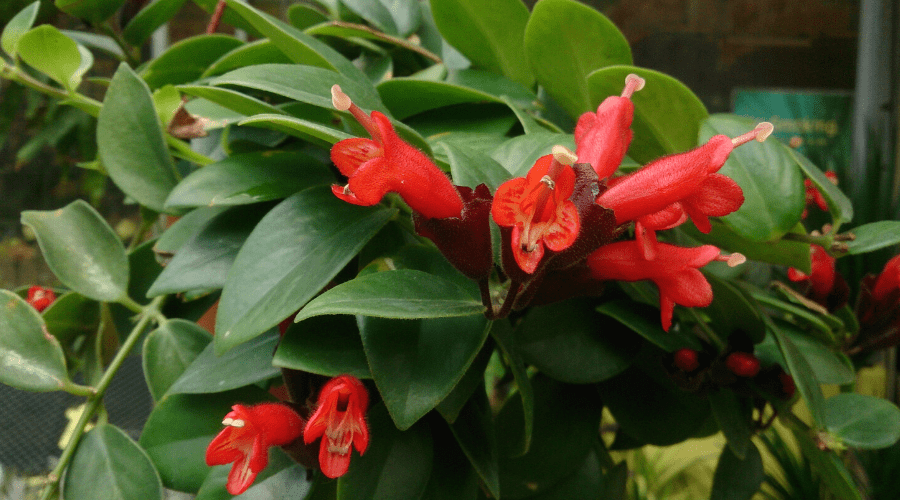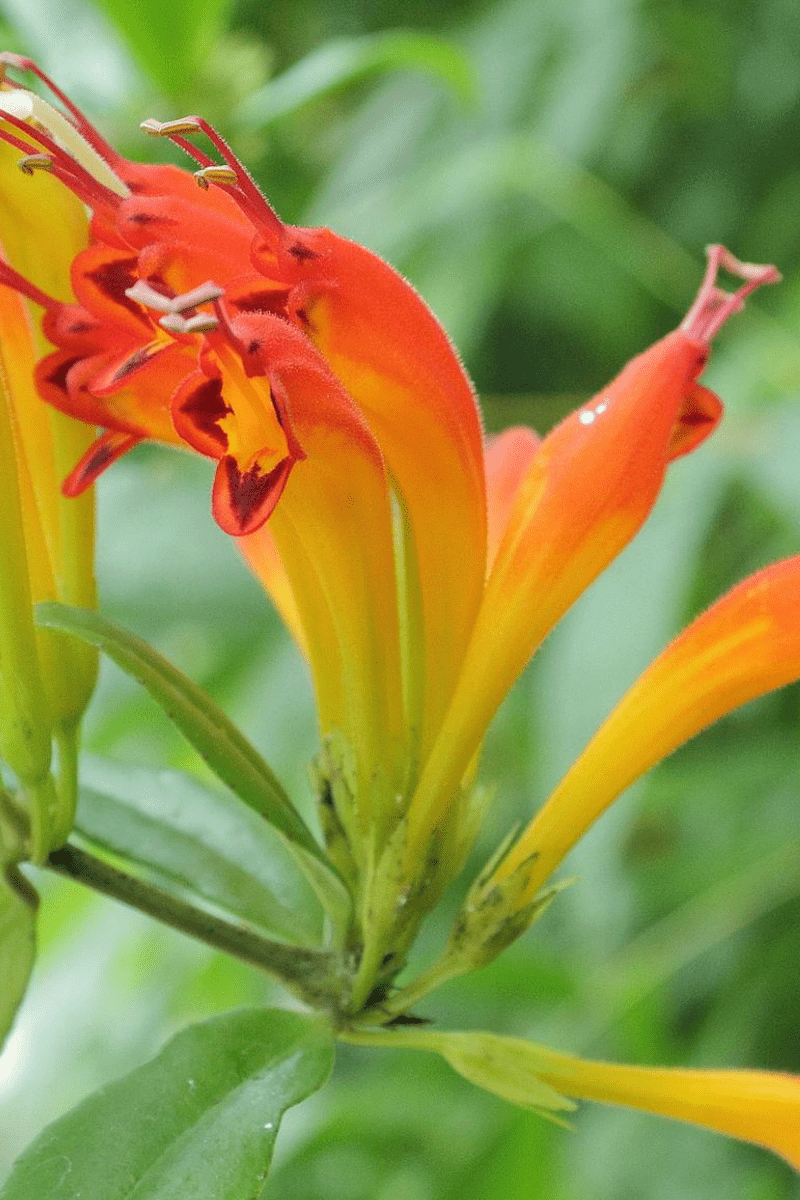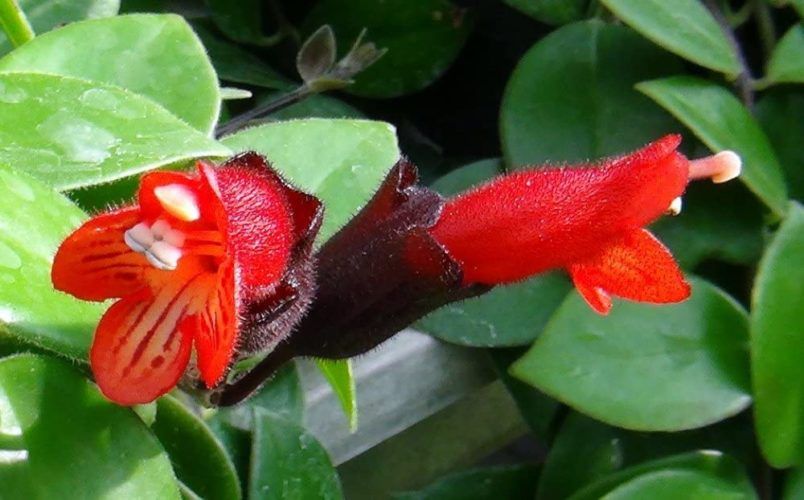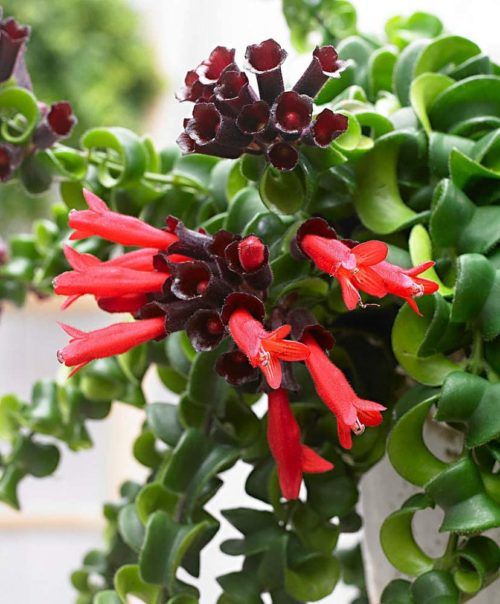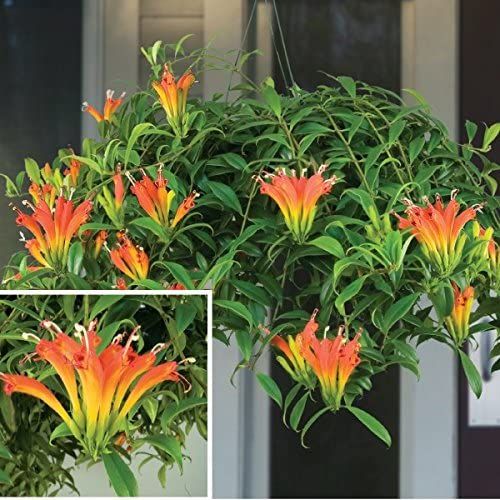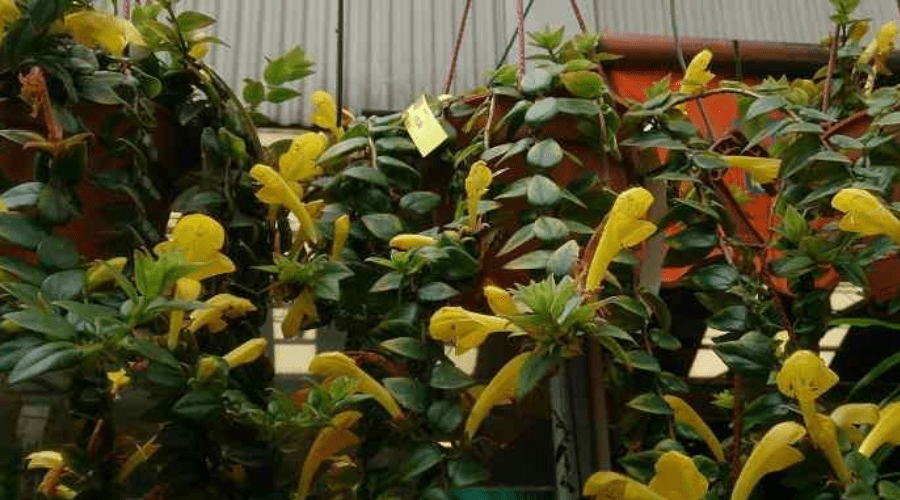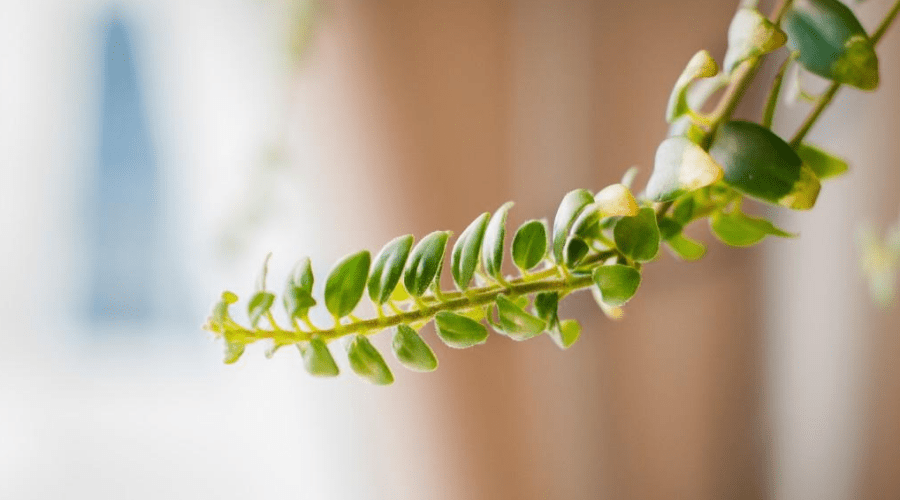Very few flowering houseplants are as interesting or easy to care for as the lipstick plant. With minimal soil requirements, adaptable light and humidity needs, and a strong growth habit, this is truly one of the prettiest and easiest blooming plants you can keep. Whether you’re just getting started or have an urban rainforest of lipstick plants, you’re in the right place. We’ve gathered up the best ways to care for, propagate, prune and display your Aeschynanthus plants.
Lipstick Plant Details
Aeschynanthus radicans
AKA Lipstick plant, lipstick vine
Ease of Care: easy
Light: bright indirect sunlight
Water: when top inch of soil is dry
Temperature: 65° to 80° F
Height: 2 - 3 feet
Growth Rate: moderate
Pests: spider mites, mealybugs, aphids
Diseases: Botrytis blight
Toxicity: nontoxic to people and pets
Benefits
A close relative to the African violet, the lipstick plant is a tropical vine that brings you beautiful red blooming with a well-deserved name. It is a great indoor hanging plant that combines a vivid shade of green foliage with the fiery red of the lipstick flowers. Easy to care for and beautiful overall, having a lipstick vine as a decorative plant is a magnificent idea.
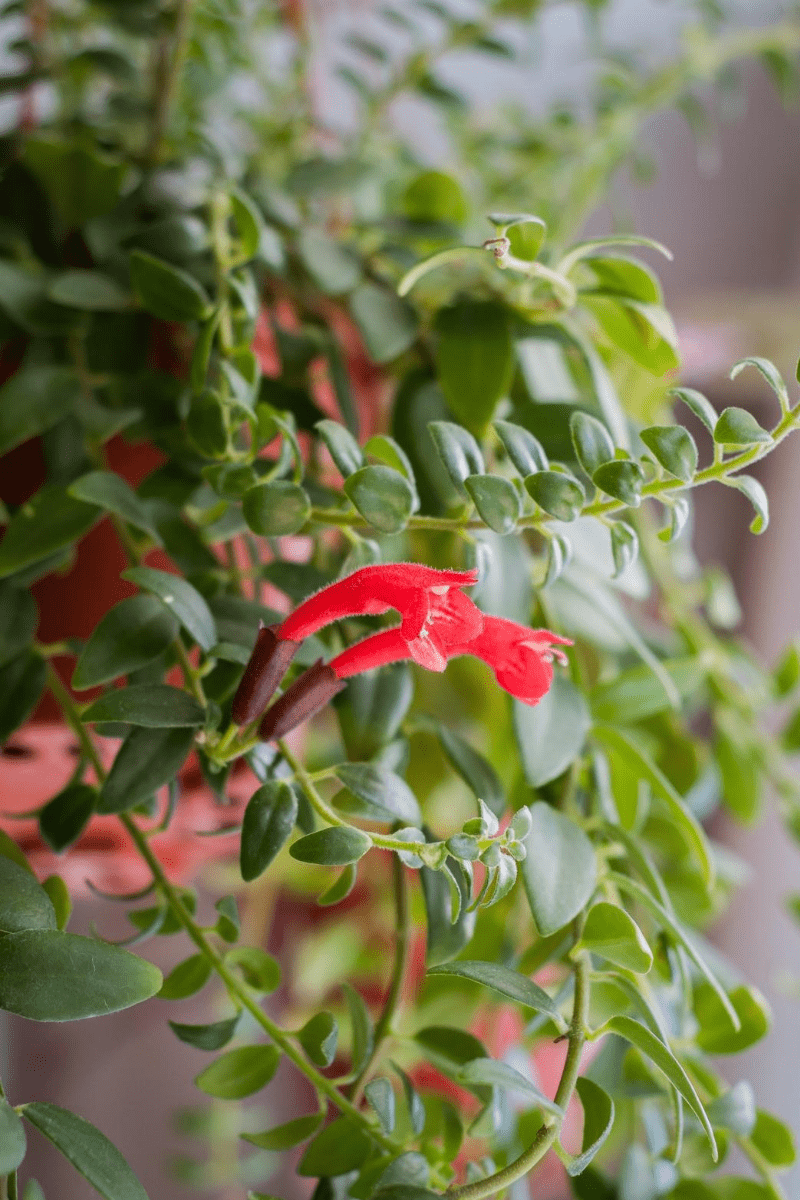 Caring for Your Lipstick Plant
Caring for Your Lipstick Plant
Caring for a lipstick plant isn’t rocket science, but there are still rules that have to be followed if you want your plant to grow happy and healthy:
Light
As with most other plants, the lipstick plant also requires bright and indirect sunlight. However, this plant will not bloom unless you give it plenty of bright light, which means that full sun and full shade need to be avoided if you want the lipstick plant to reach its maximum potential.
Water
One of the key factors in plant growth is making sure you water it properly. To put it short, the plant will get root rot if you water it too much and may not grow properly if you don’t provide it with a steady amount of water.
If you want to add tap water to the plant, make sure you leave it to sit for 24 hours before that in order to allow the chlorine to dissipate. You can start adding water when you notice the top inch of the soil is dry. Add water until you notice that it starts coming out from the bottom of the container.
When you’re done with watering the plant, make sure that you empty the bottom tray (the one that should always sit underneath a pot with a drainage hole) to avoid the soil sitting in water and soaking it up to a point where root rot becomes a problem.
Temperature
Unlike other plants, the lipstick plant is also a bit more… specific when it comes to its temperature requirements. Room temperatures have to be between 65 and 70 degrees throughout most of the year. However, some experts recommended air temperatures to be between 70 and 80 degrees if you want to make sure the plant has higher odds of blooming.
Whatever you do, make sure that temperatures during the winter do not go under 65 degrees, or else the plant won’t bloom properly during the next season. Avoid placing the plant next to air conditioning systems or vents during the winter.
Humidity
Next to air temperature, it’s also important to discuss the humidity requirements of a tropical plant such as the lipstick vine. Naturally, the plant requires a lot of humidity in order to replicate its natural growing environment, which means that you will have to turn to one of the many common ways or raising humidity levels in the room.
The easiest method is by using a humidifier, which is a stress-free alternative but also a more expensive one. You can also use an empty spray bottle filled with water to mist the plant several times a week, especially during really hot days. Most people choose to place the lipstick plant in a hanging basket, but if yours resides in a regular container, you can also add a tray with pebbles and water underneath the pot to raise humidity.
Fertilizer
A plant with blooming flowers needs fertilizer. The lipstick plant in particular likes to be fed every two weeks. You can use a water-soluble fertilizer to feed it but make sure that it has plenty of micronutrients.
Propagating Lipstick Plants
The easiest way to propagate a lipstick plant is through cuttings. To do so, you can simply adhere to the following rules:
- The night before you take your cuttings, make sure you water the plant. This will provide a good level of hydration.
- Before making the cut, locate a spot below the 4th set of leaves. Cut the two lower leaves and leave the two upper ones where they are.
- In a separate container, add a mix of ½ vermiculite/perlite and ½ peat moss. Using a finger, make a small hole in the middle of the soil and place the tip of the cutting there, but only after having dipped it in rooting hormone.
- Using a water spray bottle, mist the soil and then place the container in a sealed plastic bag. Add stakes in the pot to make sure the plastic isn’t touching the plant.
- Place the plastic bag with the container in a warm spot but make sure you avoid direct sunlight exposure.
Repotting
The good news is that the lipstick plant only requires repotting when it has outgrown the current pot. The container has to be one size larger compared to the current one. Make sure that the new container contains fertile, well-drained, and lightweight potting mix.
When you remove the lipstick plant from its current container, inspect the roots for rot and remove any diseases roots in the process. As you place the plant in its new pot, add or remove soil to make sure that you keep a consistent plant height. Then, proceed with adding soil and tapping it gently around the roots of the plant but firm enough to make sure there are no air patches in the soil. Add water until you notice it coming out from the bottom drainage hole.
Varieties of Lipstick Plant
The number of varieties the lipstick plant has to offer is overwhelming, to say the least. Some of the most common types are:
Mona Lisa lipstick plant
Recognizedby its dark purple red buds from which the bright red flowers emerge.
Hirt's Gardens Mona Lisa Lipstick Plant - 2 Pack
It's easy to see the reason for their common name since the lobed red flowers emerging from a maroon sheath do resemble lipsticks in tubes. Natives of the West Indies, the plants grow as epiphytes in the wild, but they're most comfortable in hanging baskets in the home.
Curly Q lipstick plant
Everything about Aeschynanthus 'Rasta' is the same as the traditional lipstick plant... except the curly shape of its dark green leaves.
Hirt's Garden Curly Lipstick Plant
A wonderful subject for a hanging basket and a resilient grower inside the house, ‘Rasta’ takes low light and a dry atmosphere and still thrives. Twisted Lipstick Plant has densely curled leaves that gracefully cascade while the bright red flowers emerge from dark maroon calyxes. ‘Rasta’ tends to bloom most heavily in late summer and early fall.
Tangerine lipstick plant
The green leaves are accompanied by orange-yellowish flowers.
Logee's Orange Lipstick Plant
Brilliant orange blooms are the first to arrive after a long winter and burst forth with color chasing away the winter blues. Orange Lipstick Plant will continue to flower all the way through summer providing a long season of blooms. Fleshy green leaves and cascading stems make it the perfect subject for a hanging basket.
Purchasing
Since there are so many different varieties of lipstick plants available, you can find plenty of online shops and nurseries that sell this beautiful indoor vine. For instance, you can visit Garden Goods to buy your very own Aeschynanthus radicans. You can also find it on Amazon.
Pests & Diseases
In general, there are three types of pests that will potentially attack your household plants: mealybugs, spider mites, and aphids. Mealybug infestations are visible when you notice cottony masses present on the stem of the plant. They act by draining the juices from the plant, so it’s important to remove them ASAP.
Spider mites will also drain the juices from the plant and they can be recognized thanks to the webs they spin. Out of all pests, spider mites can damage your lipstick plant the fastest. Aphids can be noticed on the flower buds and stems of the plant. They are pear-shaped and form masses in the aforementioned locations.
When it comes to diseases, the lipstick plant is most likely to get affected by the Botrytis blight. This disease will cause lesions and black spots to appear on the foliage of the plant. This is typically caused by high humidity levels during cold night temperatures and high summer ones.
To avoid it, mist the plant early in the morning so that the leaves can be dry by nightfall. If the infestation has already set in, you can use a fungicide to spray the plant.
Common Questions
Why are the leaves falling off my lipstick plant?
In general, the leaves of a plant will mostly signal either a watering or a light-related problem. Should you notice that the leaves of your lipstick plant are dropping, it’s mostly a sign of the plant not being watered properly. When this happens, check the top level of the soil with your fingers. If it’s dry, it’s time to add some water. If it’s moist, it could be a sign that the plant has been over watered and should leave the top inch of the coil to dry before adding water again.
How do I get my lipstick plant to flower?
The blooming process of a flowering plant is reliant on a variety of different factors that will influence the way it grows. As far as the lipstick plant is concerned, you want to make sure that the room its placed in meets the right conditions in terms of light and temperature, as well as water. You should also feed the plant according to the instruction given in the “Care” section of this article.
Should I prune my lipstick plant?
Pruning this plant is necessary when you want bushier growth. If that’s your desire, you simply have to cut back long stems, which helps prevent leggy growth. Don’t prune the lipstick plant until after it’s finished blooming. Pruning is also a good idea if you want your plant to produce more blooms. Make sure that you use a sterilized pair of gardening scissors or pruners to avoid any diseases. Cuts need to be made above a leaf node.

